Do you feel like your age is keeping you from being as healthy as you want?
Today, I want to discuss a massive misunderstanding about exercise and aging. Although physical and health changes during middle age may alter your health, age is less of a limitation than you may think.
Let’s dive into the loss of muscle strength and function that comes with aging, how age relates to exercise and health, and what this all means for you.
Physical and Health Changes During Middle Age
We all experience changes that age imposes on us.
We may start to slow down in middle age or feel like we don’t bounce back as quickly.
A study on the effects of exercise and aging on skeletal muscle shows we go through changes like a substantial loss of muscle mass and strength or compromised physical performance. But the study also determines that exercise is the best countermeasure for muscle aging1.
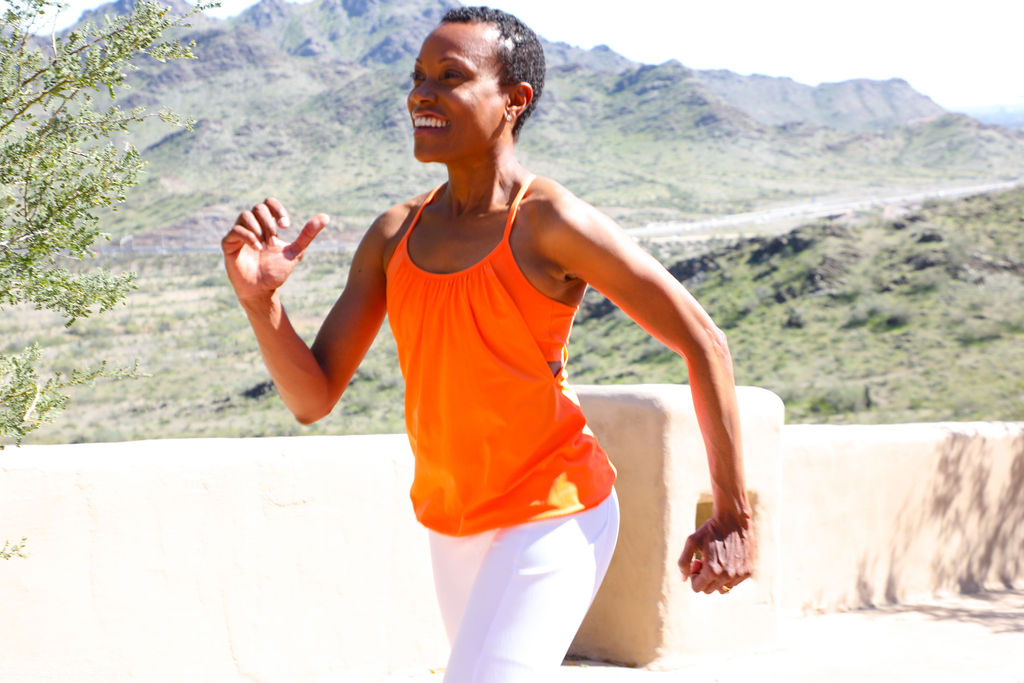
Your lifestyle or other diseases could be the main culprit.
A study that explored the association between lifestyle and overall health found that physical activity is the top way to lower frailty2. Other considerations included diet, alcohol intake, and smoking.
What this means is that sometimes our bodies are not functioning at maximum capacity. But we still have opportunities to fix them.
We can improve upon our health and strength. And the best way to do so is through physical activity.
The Myth About Exercise and Aging: Age is Not the Barrier
The greatest myth surrounding exercise and aging is that your age holds you back.
In fact, many people who continue to work out in older age perform better than their 30-year-old-selves.
In a study on the plasticity of aging, researchers explored how age is bound and goes on to determine your maximum potential performance3.
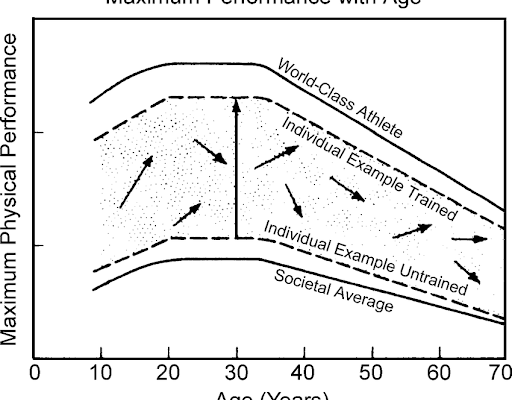
The image above shows how physical performance relates to age.
As the image explains, physical performance starts to decline around 35 to 40 years of age. World-class athletes typically sit at the ceiling or the limits of what someone in their age group can perform, where the average, untrained person sits near the bottom of the chart.
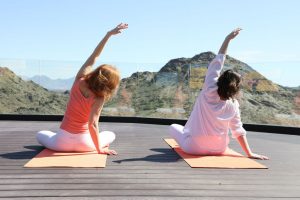
The chart also shows that the 70-year-old athlete has twice the physical potential of an untrained 30-year-old.
This means that age is not the barrier for most of us. Unless you’re maximally trained, you can work to gain more balance, endurance, and strength – even if you’re older.
Age does not limit your function.
Keep Improving Your Exercise and Health as You Age
With age comes a functional ceiling. However, the National Institute on Aging claims that physical activity is a crucial part of healthy aging<sup4.
The reason? If you keep going, you keep improving.
What this means is that if you get tired in the afternoon or have trouble keeping up with the grandkids, you can improve.
One of the best examples of how you can increase your physical performance is a case study of a 100-year-old centenarian cyclist’s maximal oxygen consumption<sup4.
It’s how long you live.
Your VO2 max ties to all the factors that go into how you feel as you age. And aerobic training improves your VO2 max levels – no matter your age or the challenge you’ve had in the past.
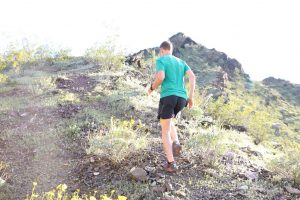
The result? He ramped up his fitness between the ages of 101 and 103.
By age 103, he improved on all the metrics substantially. The centenarian was able to increase his maximal oxygen consumption and overall performance between 15 and 20%, and even his power wattage reached levels much higher than the average untrained person.
Regular exercise aids your muscles, lungs, heart, and circulatory system function. The benefits extend to lower blood pressure, increased joint and bone health, and even a lower chance of diabetes, heart disease, or colon cancer.
Seniors often have compromised immune function, but exercise improves the entire system. Many studies have shown that daily physical activity prevents the diseases listed above and even helps manage any conditions you may already have.
With regular physical activity, you can also boost your cognitive function – lowering your risk of dementia.
Age is No Excuse to Avoid Physical Activity
With the elderly population growing, more people than ever are moving into old age with a sedentary lifestyle. Many people think it’s normal to retire and settle into a state of rest.
Others find excuses to avoid physical activity, blaming the choice on age. You may think, “my body doesn’t bounce back like it used to” or “I’m afraid I might hurt myself.”
While these are valid concerns, you can come up with tons of reasons not to exercise. Age is not a valid excuse to avoid physical activity. It’s not your age that’s telling you to rest. (Read More: Why You Should Stop Exercising).
No matter your age, stillness is terrible for the body. Regular exercise each day, even in moderate amounts, is essential to remain in good health.
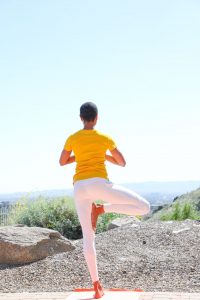
Many older adults with health conditions try physical activities that are safe and build up slowly. Exercise like walking, swimming, biking, gardening, and weightlifting are considered safe.
For safety, talk to your doctor about how your condition may affect your activity. For example, flexibility exercises like yoga or tai chi can help relieve stiffness if you have arthritis. Increasing your balance and coordination also helps reduce your risk of falls. (Read More: What Is The Best Exercise?)
The True Story About Exercise and Aging
Physical activity is good for you, no matter your age.
If you can make it a daily priority in your adult life, you may be able to prevent disease, lower your risk of falls, and even boost your overall well-being in old age.
You can start at any age and push yourself to reach physical goals beyond those you ever achieved at a young age.
So grab your favorite older adult if you need an exercise buddy and get moving! Join a club or fitness class. Find an exercise you love, and use it to maintain your health for years to come!
Resources
2 – https://pubmed.ncbi.nlm.nih.gov/29477949/
3 – https://www.researchgate.net/figure/The-Plasticity-of-Aging-Within-the-biological-potential-of-the-organism-are-multiple_fig8_261819708
4 – https://www.nia.nih.gov/health/exercise-physical-activity
5 – https://journals.physiology.org/doi/pdf/10.1152/japplphysiol.00569.201
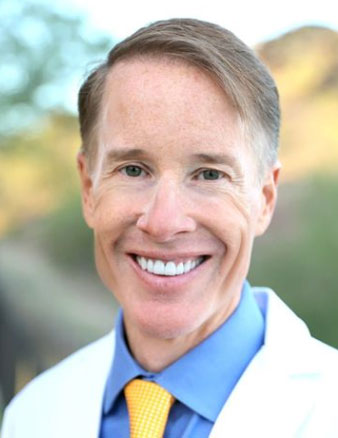
P.S. Whenever you are ready, here is how I can help you now:
1. Schedule a complimentary consultation with one of my team of naturopathic doctors. This is a great starting point for assessing your unique health needs and treatment options.
2. Download and use my Favorite Recipes Cookbook Here
3. Check out my podcast Medical Myths, Legends, and Fairytales Here
Dr. Alan Glen Christianson (Dr. C) is a Naturopathic Endocrinologist and the author of The NY Times bestselling Adrenal Reset Diet, The Metabolism Reset Diet and The Thyroid Reset Diet.
Dr. C’s gift for figuring out what really works has helped hundreds of thousands of people reverse thyroid disease, lose weight, diabetes, and regain energy. Learn more about the surprising story that started his quest.


